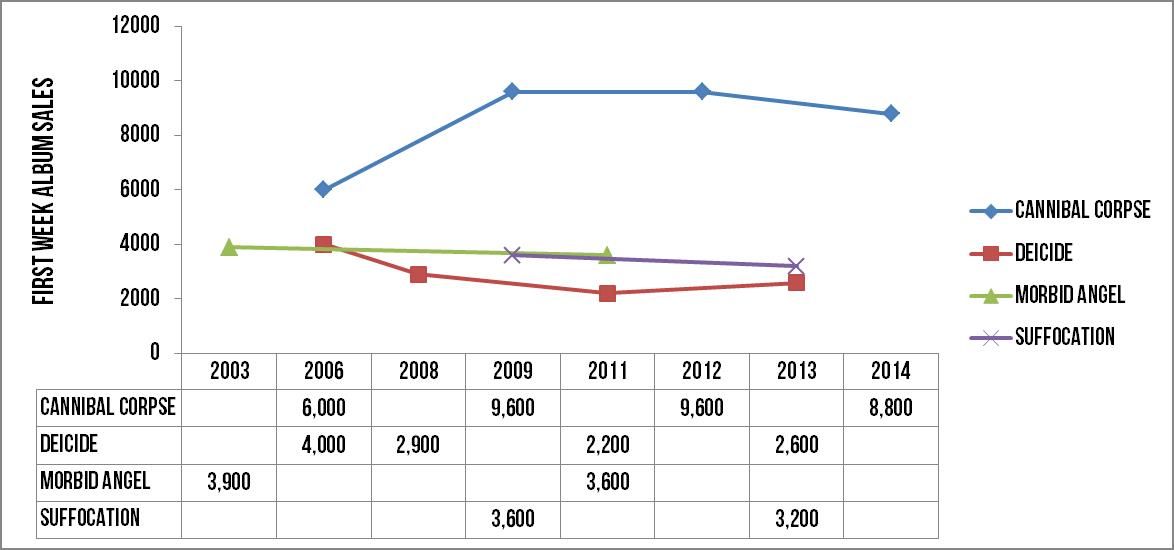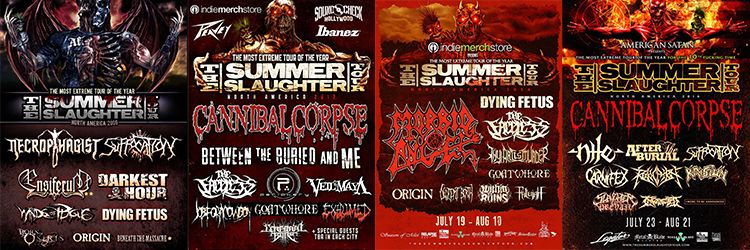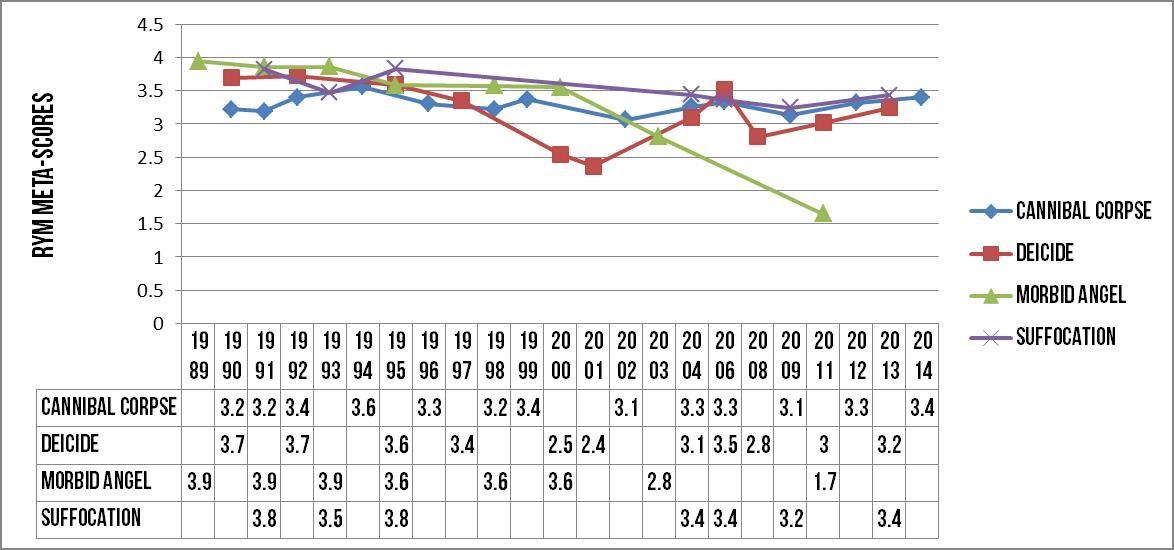Way back in 2012, Paul Mazurkiewicz (drummer for Cannibal Corpse) sat down with Billboard (via Metal Injection) and was posed an interesting question: who are death metal’s Big 4? Now, boiling any genre down to a definitive group of four is realistically impossible – as important as the Big 4 of thrash are to the genre, bands like Sepultura, Overkill, Kreator and Destruction deserve just as significant a portion of credit. So too was the case with Mazurkiewicz’s naming of Cannibal Corpse, Morbid Angel, Deicide and Suffocation as the Big 4 of death metal, which leaves out a whole slew of bands seminal to the genre’s evolution (Death, Bolt Thrower, Obituary, Autopsy, Carcass and innumerable others). Yet, in terms of balancing popularity, influence and an active status, it’s hard to argue with Mazurkiewicz’s picks; all four bands are nothing short of genre pioneers who played pivotal roles in defining death metal from its post-thrash transitional stage. However, when we fast forward to the genre’s current landscape, it’s clear time hasn’t been as kind to the infamous blasphemers from the Sunshine State as it has for the rest of DM’s Big 4. Despite being near the top of the pack in terms of influence and album sales, Deicide has experienced a noticeable fall from grace from their prime in the early-nineties. But the question is – why? What caused these luminaries to become lost?

Once Upon the Cross, Deicide Were Alpha Males
Death metal began by branching off of a foundation laid by thrash metal, and by the mid-eighties, bands like Death and Possessed were laying the final planks for a launching pad to propel the genre into its own definitive style. From the late-eighties through the early-to-mid-nighties, countless foundational classics would put this launching pad to good use and establish the careers of of mainstays within the genre. Included in this group are Mazurkiewicz’s Big 4 of DM, all of whom released some of their best albums within this time frame – Morbid Angel’s Altars of Madness (1989), Deicide’s Deicide (1990), Suffocation’s Effigy of the Forgotten (1991) and Cannibal Corpse’s Tomb of the Mutilated (1992), to name a few.
But the Big 4 of DM’s appeal stretches beyond their influence. Except for Suffocation, the remainder of the Big 4 represent the best-selling death metal bands of the SoundScan era (Nielsen‘s measurement of music sales and streaming beginning May 25, 1991) by a pretty healthy margin. According to the most recent figures (which are unfortunately rather dated), total SS era sales place Cannibal Corpse (558,929), Deicide (481,131) and Morbid Angel (445,147) as the top three sellers among death metal bands, with over 70,000 units separating MA from the number four top-seller Six Feet Under (370,660). Yet, while Morbid Angel’s Covenant (1993) is considered the best-selling death metal album of the SS era with 127,154 units sold, Deicide’s self-titled debut (110,719) is believed to be deserving of the top spot due to pre-SS era sales.
Of course, album sales have diminished greatly for all artists since the SS era began, particularly for those in the underground. The Big 4 of DM hasn’t been immune to this trend, with Cannibal Corpse being the only band of the group to be doing relatively well considering the current music sales landscape. But while Morbid Angel and Suffocation have remained fairly steady in recent years, Deicide has both the lowest sales figure and largest sales gap of all four bands:

Source: Blabbermouth. Figures depict sales of the bands’ full-length albums from their respective years.
Granted, there are a number of factors that likely contributed to this, and album sales certainly aren’t a measure of quality by any means. They are, however, the best available barometer for active popularity, and the numbers show the strongest downward trend among the Big 4 of DM’s sales is death metal fans’ interest in purchasing Deicide’s music. This isn’t the sole proof of and reason for Deicide’s decline, but it’s certainly a significant one. Labels, concert promoters and booking agents all use sales figures (and, eventually, streaming service volume) to gauge public interest in a band’s latest output and whether or not they will push comparable units in the future or be able to fill venues. Unfortunately, the latter gauge is another area in which Deicide has seen a steady decline.

A Shrinking Legion of Fans
When it comes to headlining death metal tours, nobody can stack their bills as easily as Cannibal Corpse. Their past few tour cycles have attracted support from a who’s-who of extreme metal, including Behemoth, Cryptopsy, Obituary, Abysmal Dawn, Cattle Decapitation, Napalm Death, Immolation, Skeletonwitch and others. This is true for Suffocation, who’ve also landed support from Cattle Decap and Skeletonwitch in addition to Decapitated, Exhumed and more. And while Morbid Angel hasn’t toured regularly in recent years, they’ve landed top billing at both 2017’s Maryland Deathfest and 2014’s Summer Slaughter Tour. In fact, all three bands have at least co-headlined Summer Slaughter once or more since 2009:

So where does Deicide fit in on the action? To be fair, they’ve also drawn some big names as support, including Septicflesh, Inquisition, Abysmal Dawn, Belphegor and Marduk, and it wasn’t their fault that their headlining gig for last year’s Metal Alliance Tour (with Hate Eternal and Black Crown Initiate) went up in flames. But while this isn’t meant to devolve into a dick measuring contest, Deicide’s supporting acts are either not as big or not as currently popular as many of the other Big 4 of DM’s support bands. And more importantly, the last two years have seen that deficit widen significantly. Cannibal Corpse, Morbid Angel and Suffocation have been or will be touring with two of the biggest tours in metal (MDF and SS) in 2016 and 2017. Deicide? Well, they did a brief headlining tour of the Midwest and West Coast with sole support from the relatively unknown Season of Suffering.
This is important for a couple of reasons, the first of which is tied to Deicide’s declining album sales. It appears as though the band hasn’t retained the confidence of booking agents enough to lead the charge on a truly stacked tour, which is the complete antithesis of what the remainder of the Big 4 of DM have exhibited. But more importantly, these other three bands have made it a point to tour with fresh, popular metal bands that may attract younger fans who haven’t delved as deeply into metal’s classic acts. With Deicide, many of their supporting acts are either fellow veteran bands or newer acts that haven’t truly broken through yet, shrinking the window for discovery among younger metal fans. While it’s impossible to nail down exactly why people pay for certain albums and concert tickets instead of others, there are two solid hypotheses that may explain why metal fans have lost interest in Deicide.

To Hell with God and the Blasphemy Shtick
Even a cursory glance of Deicide’s imagery and album covers should make the band’s anti-theist campaign blatantly obvious. Not only is their name a condensed term for deistic murder, the bulk of their lyrics deal exclusively with the topics of blasphemy and anti-Christian rhetoric. Not to mention that frontman Glen Benton was infamous for branding an inverted cross into his forehead. The degree to which Benton and the band believe in this rhetoric is irrelevant, as it definitely contributed to a “taboo” appeal when they first debuted. Similar to Cannibal Corpse, bans have been placed on Deicide’s music and their ability to perform in various countries, which always piques the interest of adolescents whom governments and parents are trying to “protect” by instituting these bans. But it’s been almost 30 years since Deicide debuted, and their message hasn’t changed a bit in that time frame. The problem with this isn’t that they’re necessarily wrong or right in their beliefs, but rather something much simpler: it’s grown stale.
Now, of course, there’s no shortage of religion-bashing in metal’s history, especially with more extreme genres like death and black metal. But you’d be hard-pressed to find many other bands as atonal in their anti-Christian rhetoric as Deicide, to the point that they’ve become a foil for overly preachy Christian metalcore bands. Again, this isn’t an indictment of their rhetoric’s substance; there are plenty of reasons to critique organized religion and several methods with which this can be achieved. But when you’re served the same exact thing on album after album, it becomes less like comfort food and more like a heaping pile of reheated slop for every meal. Consistency may be a welcome attribute among metal fans, but bands like Deicide shouldn’t conflate being consistent with being repetitious. In an age of short-attention spans, you can’t give listeners a repackaged album time after time and expect them to stick around.

Till Death Do Us Part, Dated Death Metal Sound
As much of a problem as this is in terms of Deicide’s lyrics, the repetition of their music is an even bigger issue. While each member of the Big 4 of DM has their own distinct sound, Deicide’s is perhaps the best embodiment of plain, unadulterated death metal. They’re truly the only band of the four to not go through a noticeable overhaul of their sound over the entirety of their career. To help illustrate why this is problematic, here’s a graph outlining each bands’ meta-scores on Rate Your Music (there are a few issues with aggregate sites like RYM, but they provide the best available source of info on how listeners feel about an album):

Source: RYM, data extracted 9/3/16. Figures depict ratings of the bands’ full-length albums from their respective years.
Both Cannibal Corpse and Suffocation have maintained the most consistent ratings among the Big 4 of D, which can be attributed to a steady progression of their respective takes on the genre. Due to the separate Barnes and Corpsegrinder eras and a boost from both controversy and overly grotesque songs and imagery, Cannibal Corpse was able to build a sold career on a handful of classic albums and songs between Eaten Back to Life (1990) and Vile (1996). From Gallery of Suicide (1998) onward, the band was able to use a combination of increased production quality and self-refining to establish a comfortable but satisfying sound, bolstered by the constant amassing of fans via touring as stated above.
Suffocation followed a slightly different path, due primarily to larger gaps between releases because of a long, mid-career hiatus and band members’ preferences to take it easy in terms of recording and touring. What’s played to Suffocation’s favor is how insanely influential their sound became for a variety of death metal subgenres. Tech death, deathcore and brutal death metal all draw distinct influence from Suffocation (among others), and this kind of Six Degrees of Kevin Bacon effect has helped them maintain their relevancy among both younger bands and fans. It’s also why their two most famous and influential albums – Effigy of the Forgotten (1991) and Pierced From Within (1995) – are likely rated so highly. Tack on subtle self-refining and progressive leanings, and you have the makings for a healthy, stable career.
Now we come to Morbid Angel and the most divisive discography of the Big 4 of DM by a long shot. Holding both the highest and lowest ratings of all four bands, Morbid Angel has had an extremely varied career by death metal standards, which comes with some obvious ups and downs. You can read about their discography in detail with our Half-Life feature on them, but here’s a quick synopsis: classics like Altars of Madness (1989) and Covenant (1993) are consistently regarded as two of the best – or at least most important – death metal albums of all time, along with deeper cuts like Blessed are the Sick (1991) and Domination (1995). When frontman David Vincent left the band after the release of Domination, the addition of his replacement Steve Tucker brought out a different side of the band, with the ultra-fast and mildly progressive Formulas Fatal to the Flesh (1998) and the death/doom-laden Gateways to Annihilation (2000), both of which are severely underrated. By the time Heretic (2003) dropped, their sound had finally become stagnant, and when the band returned years later after breaking up to drop Illud Divinum Insanus (2011)…well, you probably know how that turned out. But other than a moment of stagnation and dropping the St. Anger of death metal, Morbid Angel remained relevant by simply making consistently excellent music and knowing when was the right time to mix things up (some results being better than others).

In the Minds of Evil is an Unwillingness to Change
While Deicide has employed some of the aforementioned tactics, they haven’t done so with the frequency or efficacy needed to stay relevant, which has been the primary reason for their decline. Similar to Morbid Angel’s pair of classic albums, Deicide has a couple of their own, with Deicide (1990) and Legion (1992) being two of the highest rated albums among all four bands’ discographies. And though both bands also experienced two sharp declines, there’s a key difference between them. Heretic and IDI were both flukes in Morbid Angel’s discography produced by two different lineups at separate times. However, these moments of stagnation and failed experiments (respectively) are not indicative of the reception their discography as a whole has received. More importantly, Morbid Angel didn’t make the same mistake twice; these poor offerings are individual mistakes that didn’t create a trend (Heretic) and almost certainly won’t be replicated (IDI).
On the other hand, Deicide’s discography is defined by multiple stretches of consecutive poor albums. There are a handful of clear negative trends in their career that have added up to an overarching issue that’s haunted the band since their first two classic album. Deicide’s decline began slowly after Legion, eventually turning into a free fall with Insineratehymn (2000) and In Torment in Hell (1991). With the former, the band had clearly choked out the last of what their original sound had to offer, and with the latter, the band has gone on record as saying the writing and recording process was rushed and led to a weak album.
A few years later, Deicide would experience their first bounce back with Scars of the Crucifix (2004) and The Stench of Redemption (2006), which utilized a combination of invigoration after the failure of ITIH and higher production quality to produce a rebooted – if not reinvented – rendition of the band’s sound. But then, once again, Deicide fell back into their old ways, as Till Death Do Us Part (2008) was yet another helping of reheated slop from a band who can’t really afford to offer so few menu options. And even though their most recent pair of records – To Hell With God (2011) and In the Minds of Evil (2013) – have given the band their second bounce-back, you’ll notice that the post-comeback ratings are a bit lower this time around, and moreover, none of their recent output indicates they’ll reach the height of their glory days.
And herein lies Deicide’s apparent ethos and core problem – offering more of the same. Again, rebooting and reinventing are not synonymous, and as is apparent by their ratings and sales figures, metal fans have taken notice. There’s nothing wrong with Deicide playing to a core demographic of diehard fans and digging their heels in the ground; that’s their prerogative, and nothing anyone says will change a band set in their ways. But while fame and fortune isn’t everything, making good music should be, and Deicide seems to have a vested disinterest in all three of these metrics of what it means to be a successful band. We don’t need Legion, Pt. 2; we just want a reason to love the band again.